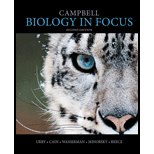
Campbell Biology in Focus (2nd Edition)
2nd Edition
ISBN: 9780321962751
Author: Lisa A. Urry, Michael L. Cain, Steven A. Wasserman, Peter V. Minorsky, Jane B. Reece
Publisher: PEARSON
expand_more
expand_more
format_list_bulleted
Concept explainers
Question
Chapter 29.7, Problem 1CC
Summary Introduction
To identify:
The plant organs that are sugar sources, that are sugar sinks, and organs that might be either.
Introduction:
Phloem is the tissue that transports the photosynthetic product or its analogs from one part of plant to another. The xylem tissues transport the water and nutrients from roots to the leaves in the unidirectional manner, whereas the phloem allows the movement of sap where it is required.
Expert Solution & Answer
Want to see the full answer?
Check out a sample textbook solution
Students have asked these similar questions
What are the structure and properties of atoms and chemical bonds (especially how they relate to DNA and proteins).
The Sentinel Cell: Nature’s Answer to Cancer?
Molecular Biology Question
You are working to characterize a novel protein in mice. Analysis shows that high levels of the primary transcript that codes for this protein are found in tissue from the brain, muscle, liver, and pancreas. However, an antibody that recognizes the C-terminal portion of the protein indicates that the protein is present in brain, muscle, and liver, but not in the pancreas. What is the most likely explanation for this result?
Chapter 29 Solutions
Campbell Biology in Focus (2nd Edition)
Ch. 29.1 - Why is long-distance transport important for...Ch. 29.1 - Prob. 2CCCh. 29.1 - WHAT IF? Some plants can detect increased levels...Ch. 29.2 - If a plant cell immersed in distilled water has a...Ch. 29.2 - How would a reduction in the number of aquaporin...Ch. 29.2 - WHAT IF? What would happen if you put plant...Ch. 29.3 - Prob. 1CCCh. 29.3 - WHAT IF? If an element increases the growth rate...Ch. 29.3 - Prob. 3CCCh. 29.4 - Prob. 1CC
Ch. 29.4 - Prob. 2CCCh. 29.4 - Prob. 3CCCh. 29.5 - A scientist adds a water-soluble inhibitor of...Ch. 29.5 - WHAT IF? Suppose an Arabidopsis mutant lacking...Ch. 29.5 - Prob. 3CCCh. 29.6 - Prob. 1CCCh. 29.6 - WHAT IF? If you buy cut flowers, why might the...Ch. 29.6 - Prob. 3CCCh. 29.7 - Prob. 1CCCh. 29.7 - Prob. 2CCCh. 29.7 - Prob. 3CCCh. 29 - Which structure or compartment is part of the...Ch. 29 - Prob. 2TYUCh. 29 - Prob. 3TYUCh. 29 - What would enhance water uptake by a plant cell?...Ch. 29 - Prob. 5TYUCh. 29 - Compared with a cell with few aquaporin proteins...Ch. 29 - Two groups of tomatoes were grown in the...Ch. 29 - Prob. 8TYUCh. 29 - Prob. 9TYUCh. 29 - SCIENTIFIC INQUIRY A Minnesota gardener notes that...Ch. 29 - Prob. 11TYUCh. 29 - FOCUS ON INTERACTIONS The soil in which plants...Ch. 29 - Prob. 13TYU
Knowledge Booster
Learn more about
Need a deep-dive on the concept behind this application? Look no further. Learn more about this topic, biology and related others by exploring similar questions and additional content below.Similar questions
- Molecular Biology Explain/discuss how “slow stop” and “quick/fast stop” mutants wereused to identify different protein involved in DNA replication in E. coli.arrow_forwardMolecular Biology Question A gene that codes for a protein was removed from a eukaryotic cell and inserted into a prokaryotic cell. Although the gene was successfully transcribed and translated, it produced a different protein than it produced in the eukaryotic cell. What is the most likely explanation?arrow_forwardMolecular Biology LIST three characteristics of origins of replicationarrow_forward
- Molecular Biology Question Please help. Thank you For E coli DNA polymerase III, give the structure and function of the b-clamp sub-complex. Describe how the structure of this sub-complex is important for it’s function.arrow_forwardMolecular Biology LIST three characteristics of DNA Polymerasesarrow_forwardMolecular Biology RNA polymerase core enzyme structure contains what subunits? To form holo enzyme, sigma factor is added to core. What is the name of the structure formed? Give the detailed structure of sigma factor and the function of eachdomain. Please help. Thank youarrow_forward
- Molecular Biology You have a single bacterial cell whose DNA is labelled with radioactiveC14. After 5 rounds of cell division, how may cells will contain radioactive DNA? Please help. Thank youarrow_forward1. Explain the structure and properties of atoms and chemical bonds (especially how they relate to DNA and proteins). Also add some pictures.arrow_forward1. In the Sentinel Cell DNA integrity is preserved through nanoscopic helicase-coordinated repair, while lipids in the membrane are fortified to resist environmental mutagens. also provide pictures for this question.arrow_forward
- Explain the structure and properties of atoms and chemical bonds (especially how they relate to DNA and proteins). Also add some pictures.arrow_forwardIn the Sentinel Cell DNA integrity is preserved through nanoscopic helicase-coordinated repair, while lipids in the membrane are fortified to resist environmental mutagens. also provide pictures for this question.arrow_forward1. Explain how genetic information is stored, copied, transferred, and expressed. Also add some pictures for this question.arrow_forward
arrow_back_ios
SEE MORE QUESTIONS
arrow_forward_ios
Recommended textbooks for you
- Health Safety And Nutrition F/Young ChildHealth & NutritionISBN:9781305144767Author:MAROTZPublisher:Cengage
 Biology (MindTap Course List)BiologyISBN:9781337392938Author:Eldra Solomon, Charles Martin, Diana W. Martin, Linda R. BergPublisher:Cengage Learning
Biology (MindTap Course List)BiologyISBN:9781337392938Author:Eldra Solomon, Charles Martin, Diana W. Martin, Linda R. BergPublisher:Cengage Learning Biology 2eBiologyISBN:9781947172517Author:Matthew Douglas, Jung Choi, Mary Ann ClarkPublisher:OpenStax
Biology 2eBiologyISBN:9781947172517Author:Matthew Douglas, Jung Choi, Mary Ann ClarkPublisher:OpenStax


Health Safety And Nutrition F/Young Child
Health & Nutrition
ISBN:9781305144767
Author:MAROTZ
Publisher:Cengage


Biology (MindTap Course List)
Biology
ISBN:9781337392938
Author:Eldra Solomon, Charles Martin, Diana W. Martin, Linda R. Berg
Publisher:Cengage Learning

Biology 2e
Biology
ISBN:9781947172517
Author:Matthew Douglas, Jung Choi, Mary Ann Clark
Publisher:OpenStax
